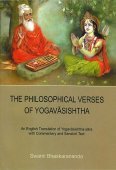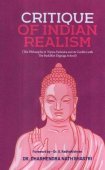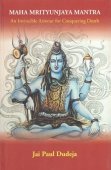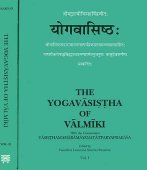Non-existence: 2 definitions
Introduction:
Non-existence means something in Hinduism, Sanskrit. If you want to know the exact meaning, history, etymology or English translation of this term then check out the descriptions on this page. Add your comment or reference to a book if you want to contribute to this summary article.
In Hinduism
Natyashastra (theatrics and dramaturgy)
Source: Shodhganga: Elements of Art and Architecture in the Trtiyakhanda of the Visnudharmottarapurana (natya)Non-existence is associated with Kolapadma-hasta: one of the twenty-two Single-hand Gestures (in Indian Dramas) (known as asaṃyuktahastas), according to the Viṣṇudharmottarapurāṇa, an ancient Sanskrit text which (being encyclopedic in nature) deals with a variety of cultural topics such as arts, architecture, music, grammar and astronomy.—In the Viṣṇudharmottarapurāṇa, it kolapadma-hasta said that to say no, to denote void and non existence, this hand posture is used. In the Nāṭyaśāstra, the kolapadma-hasta posture is suggestive of indicating prevention, sense of the sentences like “of whom are you” and “it is not”. Moreover, in case of a women’s reference of herself, this hand gesture is used.

Natyashastra (नाट्यशास्त्र, nāṭyaśāstra) refers to both the ancient Indian tradition (shastra) of performing arts, (natya—theatrics, drama, dance, music), as well as the name of a Sanskrit work dealing with these subjects. It also teaches the rules for composing Dramatic plays (nataka), construction and performance of Theater, and Poetic works (kavya).
Yoga (school of philosophy)
Source: ORA: Amanaska (king of all yogas): A Critical Edition and Annotated Translation by Jason BirchNon-Existence is denoted by the Sanskrit term Abhāva, according to the Amanaska Yoga treatise dealing with meditation, absorption, yogic powers and liberation.—Accordingly, as Īśvara says to Vāmadeva: “[...] Now, I will teach knowledge for the liberation of those people who have conquered their passion. [...] The highest reality is defined as that which is free from existence and non-existence (abhāva), without cessation and arising and beyond all imaginings [of the mind]. [...]”.

Yoga is originally considered a branch of Hindu philosophy (astika), but both ancient and modern Yoga combine the physical, mental and spiritual. Yoga teaches various physical techniques also known as āsanas (postures), used for various purposes (eg., meditation, contemplation, relaxation).
See also (Relevant definitions)
Partial matches: Non, Existence.
Query error!
Full-text (+280): Abhava, Atyantabhava, Pragabhava, Anyonyabhava, Pradhvamsabhava, Samsargabhava, Asambhava, Ajivani, Shunyavada, Bhavabhava, Asatta, Nastitva, Udvapa, Nastita, Vyatirekavyapti, Asattva, Abhuti, Anastitva, Vaikalya, Svatvabhava.
Relevant text
Search found 204 books and stories containing Non-existence; (plurals include: existences). You can also click to the full overview containing English textual excerpts. Below are direct links for the most relevant articles:
Vaisheshika-sutra with Commentary (by Nandalal Sinha)
Sūtra 9.1.5 (... there is absolute non-existence) < [Chapter 1 - Of Ordinary Perception of Non-Existence and of Transcendental Perception]
Sūtra 9.1.4 (Reciprocal non-existence or absence of identity, explained) < [Chapter 1 - Of Ordinary Perception of Non-Existence and of Transcendental Perception]
Sūtra 9.1.6 (Causes of the perception consequent non-existence) < [Chapter 1 - Of Ordinary Perception of Non-Existence and of Transcendental Perception]
Nyaya-Vaisheshika categories (Study) (by Diptimani Goswami)
Importance of Abhāva in Nyāya-Vaiśeṣika System < [Chapter 7 - Abhāva (Non-existence)]
Nature of Cause < [Chapter 8 - The Theory of Causation]
Nature of Abhāva < [Chapter 7 - Abhāva (Non-existence)]
Vakyapadiya of Bhartrihari (by K. A. Subramania Iyer)
Verse 3.11.3 < [Book 3 - Pada-kāṇḍa (11): Saṅkhyā-samuddeśa (On Number)]
Verse 3.3.66 < [Book 3 - Pada-kāṇḍa (3): Sambandha-samuddeśa (On Relation)]
Verse 3.3.61 < [Book 3 - Pada-kāṇḍa (3): Sambandha-samuddeśa (On Relation)]
Brahma Sutras (Shankaracharya) (by George Thibaut)
II, 2, 22 < [Second Adhyāya, Second Pāda]
II, 2, 26 < [Second Adhyāya, Second Pāda]
II, 1, 17 < [Second Adhyāya, First Pāda]
Apadana commentary (Atthakatha) (by U Lu Pe Win)
Commentary on the stanza on nillolupa (free from covetousness) < [Commentary on biography of Silent Buddhas (Paccekabuddha)]
Discourse on Sumedha, the Future Gotama Buddha < [Part 1 - Remote preface (dūre-nidāna)]
Brahma Sutras (Shankara Bhashya) (by Swami Vireshwarananda)
Chapter II, Section II, Adhikarana IV < [Section II]
Chapter I, Section IV, Adhikarana VIII < [Section IV]
Chapter I, Section IV, Adhikarana IV < [Section IV]
Related products



